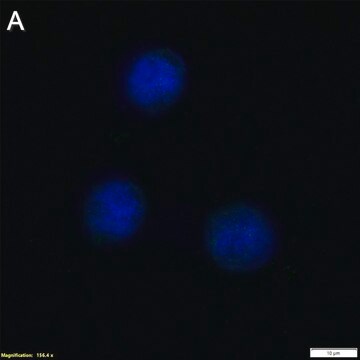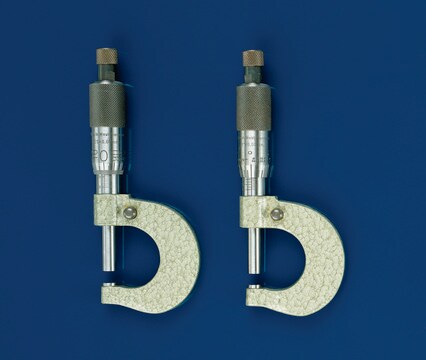07072001
ES-R1 from mouse
About This Item
Prodotti consigliati
Origine biologica
mouse embryo
Livello qualitativo
Forma fisica
liquid
Modalità di accrescimento
Adherent
Cariotipo
Not specified
Morfologia
Adherent monolayer of spheroidal cells on feeder layer of mouse primary embryonic fibroblasts
Prodotti
Not specified
Recettori
Not specified
tecniche
cell culture | mammalian: suitable
Condizioni di spedizione
dry ice
Temperatura di conservazione
−196°C
Origine della linea cellulare
Descrizione della linea cellulare
Terreno di coltura
KSR medium consists of KO-DMEM (Gibco 10829), 20% Knock-Out Serum Replacer (Gibco 10828), 2 mM Glutamine (Invitrogen 25030024), NEAA (Invitrogen 11140035), 0.1 mM ß-mercaptoethanol (Sigma M6250) and LIF 1000 Units/ml (ESGRO ESG1106).
Mantenimento delle subcolture
Porcine gelatine (Sigma G1890) is dissolved in sterile water (0.5 g/500 ml) at 56 °C. The 0.1% solution is sterilized by filtration (0.22 μm). Add 0.1% gelatine to plastic ware to cover bottom, and incubate for 20 minutes at room temperature. Remove gelatine, wash with PBS once and replace with appropriate culture medium. The flask/dish must not be allowed to dry out.
Feeder layers are prepared on the gelatinized flasks at least 24 hours in advance of being required. An ampoule is thawed in 37 °C water bath and the contents quickly transferred to a 15 ml centrifuge tube. MEF medium is added drop wise to 5 ml. Cells are centrifuged at 150 x g for 5 minutes at room temperature (RT). Cells are resuspended in 5 ml of MEF medium. Cells are counted and added to flasks containing the correct medium at 1-3 x 104 cells/cm2.
An ampoule of ES cells is thawed in 37 °C water bath and the contents quickly transferred to a 15 ml centrifuge tube. KSR medium is added drop wise to 5 ml. Cells are centrifuged at 150 x g for 5 minutes. Cells are resuspended in 5 ml of KSR medium. The prepared feeder flask is washed once with PBS and KSR medium added. ES cells should be plated at 4-5 x 104 cells/cm2. Cultures must be incubated in a humidified 5% CO2/95% air incubator at 37 °C. A 100% media change must be performed every day and cells passaged every 2-3 days. Colonies must not be allowed to touch each other as overgrowth will result in differentiation.
Altre note
Codice della classe di stoccaggio
10 - Combustible liquids
Classe di pericolosità dell'acqua (WGK)
WGK 3
Punto d’infiammabilità (°F)
Not applicable
Punto d’infiammabilità (°C)
Not applicable
Certificati d'analisi (COA)
Cerca il Certificati d'analisi (COA) digitando il numero di lotto/batch corrispondente. I numeri di lotto o di batch sono stampati sull'etichetta dei prodotti dopo la parola ‘Lotto’ o ‘Batch’.
Possiedi già questo prodotto?
I documenti relativi ai prodotti acquistati recentemente sono disponibili nell’Archivio dei documenti.
Il team dei nostri ricercatori vanta grande esperienza in tutte le aree della ricerca quali Life Science, scienza dei materiali, sintesi chimica, cromatografia, discipline analitiche, ecc..
Contatta l'Assistenza Tecnica.






